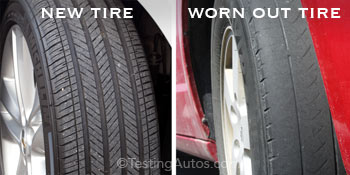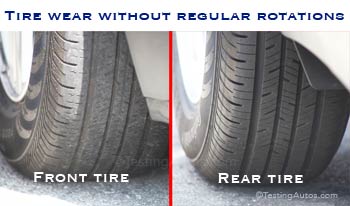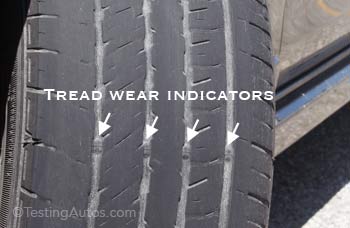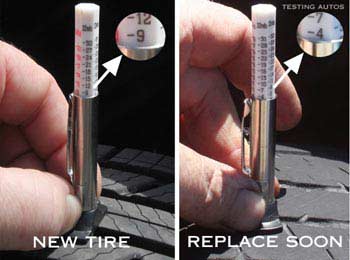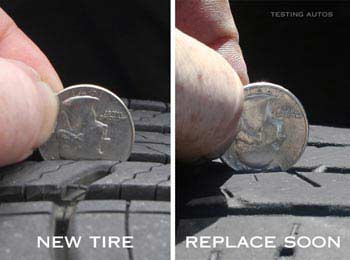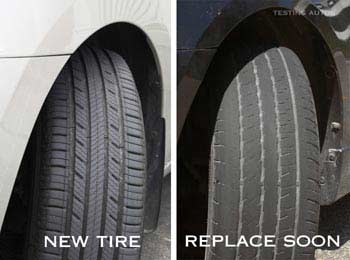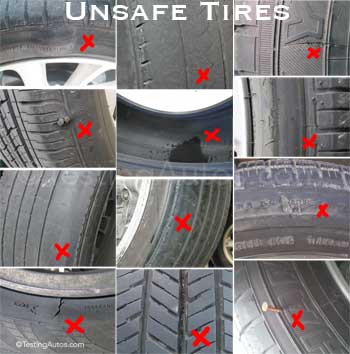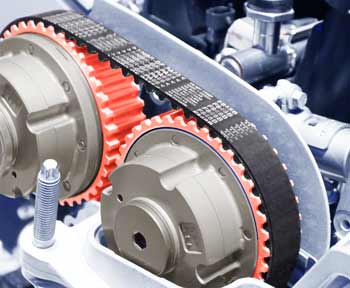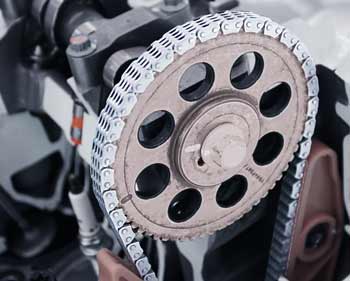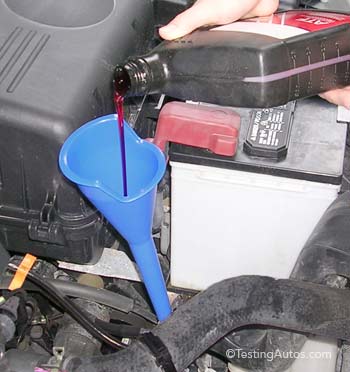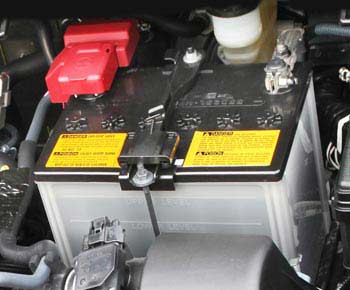When Should Tires be Replaced in a Car?
By Vlad Samarin Updated November 25, 2023
The condition of your tires is vital for staying safe on the road. Tires make a huge difference in the way the vehicle handles. The lifespan of tires varies based on several factors, and there isn't a one-size-fits-all answer. Here are some key considerations to determine when to replace your tires:
Tread Depth:
Tread depth is a crucial indicator. Most tires have built-in tread wear indicators, read more below. When the tread wears down to these indicators (usually at 3/32 of an inch or less), it's time to replace the tires.When your tires worn down to less than 5/32 of an inch, you may already notice ocassional reduced traction on wet surfaces. That's why mechanics typically mark the condition of the tread between 3/32 and 5/32 of an inch as "Yellow" on multi-point inspection sheets.
Winter tires need more grip and should be changed even earlier (at least at 4/32 of an inch). Scroll down for ways to measure the tread depth.
Tire Age:
Even if the tread looks good, tires age. As a general guideline, tires that are more than six years old, regardless of tread depth, may be due for replacement. The rubber can degrade over time, impacting performance and safety. The tire production date is imprinted on the tire DOT number as a 4-digit number, representing the week and the year.Driving Conditions:
Driving habits and conditions play a significant role. If you frequently drive in harsh conditions like extreme heat, cold, or rough terrain, your tires may wear out faster.Damages that make the tire unsafe
Regularly inspect your tires for signs of damage, bulges, cuts, or uneven wear. If you notice any of these issues, it's advisable to consult a professional for evaluation.Punctures that Cannot be Safely Repaired
If your tire has picked up a small screw or nail, in most cases it's easy to repair the puncture. However, not all punctures can be repaired. if the puncture is too large to repair or is in the sidewall or your mechanic cannot repair it safely for other reasons, the tire will have to be replaced.Uneven wear or "Cupping"
Uneven tire wear, known as cupping, occurs in some cars, creating alternating low and high spots on the tread. While cupped tires might still have sufficient tread for safety, they often produce loud noises, especially if placed at the front. If noise is an issue, replacement is necessary. To prevent cupping, address underlying causes like suspension issues, misalignment, or insufficient tire rotations.Mileage:
While mileage is a factor, it's not the sole determinant. High mileage on tires may indicate wear, but if the tread is still within safe limits, the tires might not need immediate replacement.What happens if you keep driving on worn-out tires?
Worn-out tires reduce grip in turns and on wet surfaces, increasing the risk of sliding or hydroplaning in rain and extending braking distances. All-wheel drive, Vehicle Stability Control, and Automatic Emergency Braking systems are less effective with bald tires. In essence, worn-out tires compromise vehicle safety.How to extend the life of the tires:
Proper wheel alignment and regular tire rotation can extend the life of your tires. If your vehicle is out of alignment, it can cause uneven wear, leading to premature tire replacement. Have your vehicle inspected regularly so problems with steering or suspension can be caught early. When replacing, opt for tires with a better tread life rating.Why tires need to be rotated
Tires are rotated between front and rear axles to ensure even wear. Front-wheel drive cars, prevalent today, and many all-wheel drive SUVs with a front-wheel drive base experience faster wear on front tires due to the heavier front components. Additionally, modern cars with independent rear suspension may cause inside wear on rear tires, leading to uneven wear or cupping if not rotated regularly.Tread Wear Indicator
Tread wear indicators are rubber bars built into the tread across the main grooves. Most tires have them. As the tire wears out, tread wear indicators become clearly visible. In a new tire, you can barely see them inside the grooves. In a worn-out tire like this one, the wear indicator bar is almost flush with the remaining tread material.How to Measure Tire Tread Depth with a Tire Tread Gauge?
With the tire tread gauge: You can purchase a basic tire tread gauge in any parts store. Measure the tread depth in the most worn-out area of the tire.Hold the gauge over one of the major grooves, with the foot of the gauge placed across the groove. Push the scale down lightly and check the number that is lined up with the upper end of the gauge.
The new tire shows 9/32", while the tire on the right photo shows 4/32".
How to Measure Tire Tread Depth with the Washington Quarter:
With the quarter placed upside down inside one of the major grooves, look at George Washington's head. If the head is covered by the tread, you have more than 4/32" of tread material left.If the top of the head is even with the remaining tread surface, as in the right photo, you have about 4/32" of the tread material left.
How Can You Tell Visually that Tires are Worn Out?
We took these photos of all-season tires for you. Tap on the photo to see a larger image. The tire on the left is new with 9/32 of an inch of the tread material. Tire on the right is at 4/32 of an inch and will need to be replaced soon.Photo examples of unsafe tires
The tire needs to be replaced if it's damaged and deemed unsafe. These are photos of the tires that we have seen over the years, from left to right:1. Sidewall bulge.
2. The tread is completely worn out.
3. Cut into the sidewall.
4. Puncture in the sidewall (sidewall puncture cannot be repaired).
5. Rubber shavings inside after the tire was driven flat.
6. Sidewall damage after being driven flat. Photo.
7. Uneven wear: the tire worn on one side. Photo.
8. The cord is showing.
9. Damage to the sidewall.
10. Deep cracks in the sidewall.
11. Deep cracks in the tread groves.
12. The nail in the sidewall.
How to Choose the Right Tires?
When replacing tires, you don't have to buy the same brand that was originally on the car. You can opt for any tires that fall within the car manufacturer's specifications (size, speed rating, etc.). In fact, by switching to different tires you can adjust your vehicle's handling to your preferences. If you enjoy spirited driving, you may want to switch to tires with better handling characteristics. If you like a quieter ride, you can select tires that provide better ride comfort.Advertisement
Sites like tirerack.com and consumerreports.org offer comparisons of different tires on tread life, fuel economy, ride comfort, noise level, handling in snow and other ratings. If you are looking for a better fuel economy, look for low rolling resistance tires. If you need more grip on wet roads, look for wet traction or wet braking scores. Replacing all four tires is not cheap, but it's an investment in your safety and a better driving experience.
